DIY Accessibility Switches
This guide explains how to create a disability standard switch from scratch, also known as a simple switch or mono switch.
If you're an absolute beginner, we strongly recommend that you follow "The Basic Soldering Guide" - by Alan Winstanley.
SAFETY: Always use home-made equipment under supervision, and disconnect any batteries when not in use. These adaptations are at your own risk.
The Fruit Machine buttons used here are available from most Amusement Machine dealers (see links below). An even cheaper alternative is to adapt children's toys that use simple push buttons. Most other components are commonly available from Electronics stores such as Maplin Electronics.
Buy pre-made: You can buy ready to go Switches from the OneSwitch shop.
Switch Links
- Gremlin Solutions - UK stockists of arcade parts that can order from Happ.
- Happ Controls - US stockists with a huge range of buttons and joysticks.
- Starpoint - Great range sold by Eurocoin, Suzo International and Brent Electronic.
- Tape Switch - Unique tape based switches of many different colours and sizes.
1. What you will need:
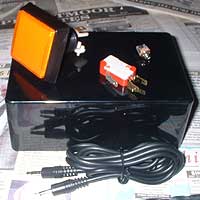
- 1x box (deep enough to house switch, such as Maplin's YN40 MB5 box)
- 1x 3.5mm mono sockets
- 1x Fruit machine push button
- 1x Microswitch
- 1x 3.5mm mono plug to plug lead
Soldering iron (15 to 30 Watt power); thin solder; soldering flux; desoldering braid; wire.
Cordless drill with drill bits (including 23mm); knife or wire strippers; small screwdriver set.
2. Make 5 holes:
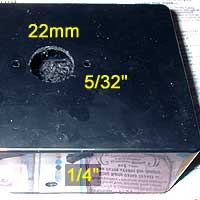
Drill 1 x 1/4" holes for the 3.5mm socket.
Drill 1 x 22mm central hole (or 25mm for the slightly larger round switches), with 2 x 4mm (5/32") holes either side (I recommend making some test attempts first then making a cardboard template).
Drill 1 small breather hole at the bottom of the box.
3. Test your socket

As not all sockets are connected alike, you will need to find which 2 of the 3 contacts you need to solder to.
Attach a test lamp or multimeter to any 2 contacts. Plug in your switch, then press it. If the lamp comes on when pressed you have the right connections, otherwise try a different combination. There's only 3 possibilities.
4. Wiring
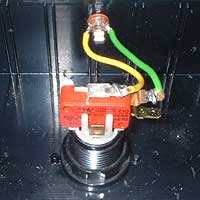
Solder two wires from the Microswitch to the 3.5mm socket - test for the correct combination before soldering.
5. Full Test

Connect the 3.5mm plug to plug lead from the switch to any adapted device (electronic dice pictured here).
Press to activate the device. Any problems - disconnect, and restudy the quality of your soldering. Use the soldering iron and soldering braid to remove, then resolder any poor joints.
Optional Illumination

Connect the additional GREEN wires as pictured. Take the trailing two green wires to a 3.5mm socket fixed in the box casing.
Plug in a 3volt to 12volt DC power supply here. The bulb should be off whilst depressed, otherwise on. Reverse the polarity if the bulb fails to light.
Finally, drill a number of vent holes in the box, to help dissipate heat produced by the bulb.

The 9 volt DC supply can be changed from 3 volts to 12 volts to adjust the brightness.
N.B.Avoid touching the bulb with your fingers, as any oily deposits on the bulb will make it burn hotter, which can warp the housing.
Typical bulbs for fruit machine buttons are 12V 0.1Amp "VCH 1112". LED equivalents are also available.
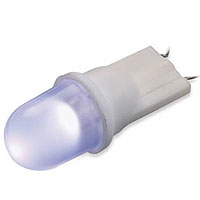
I recommend using a LED replacment for the traditional filament 501 wedge bulb. It produces a lot less heat and uses less power. It can be dimmed by adjusting the voltage supplied.
These can be sourced on-line and from some car spares shops.
Optional Daisy Chaining
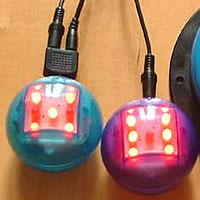
It is possible to control more than one device at a time by daisy chaining two or more sockets. You will require a 3.5mm full stereo 2-into-1 adapter (such as Maplin's FP34M) and a 3.5mm jack to jack lead (mono or stereo will work fine).
Using the 3.5mm full stereo into 2-into-1 adapter you can equally well use two switches to connect to a single socket.
D.I.Y. Text and images PUBLIC DOMAIN 2003 updated 2009 - www.OneSwitch.org.uk

